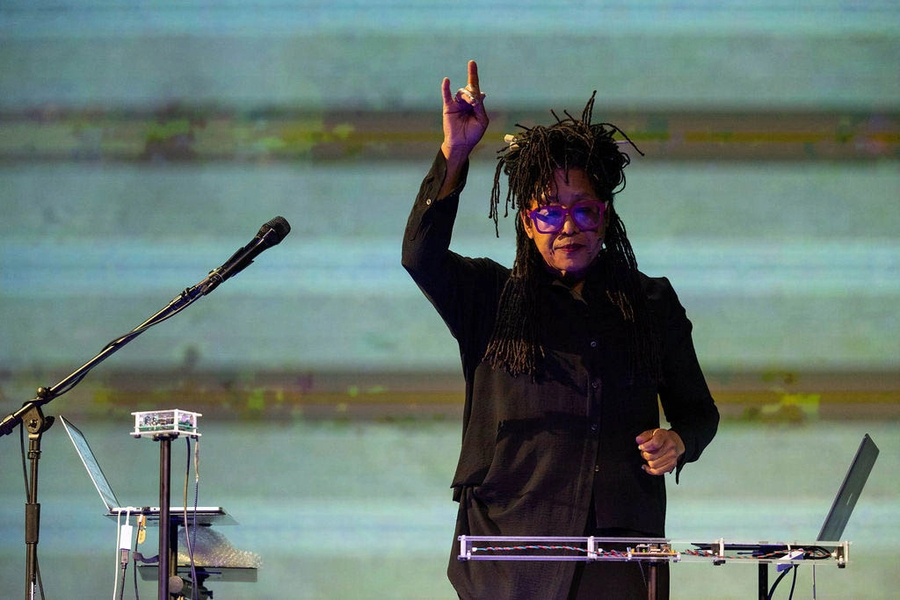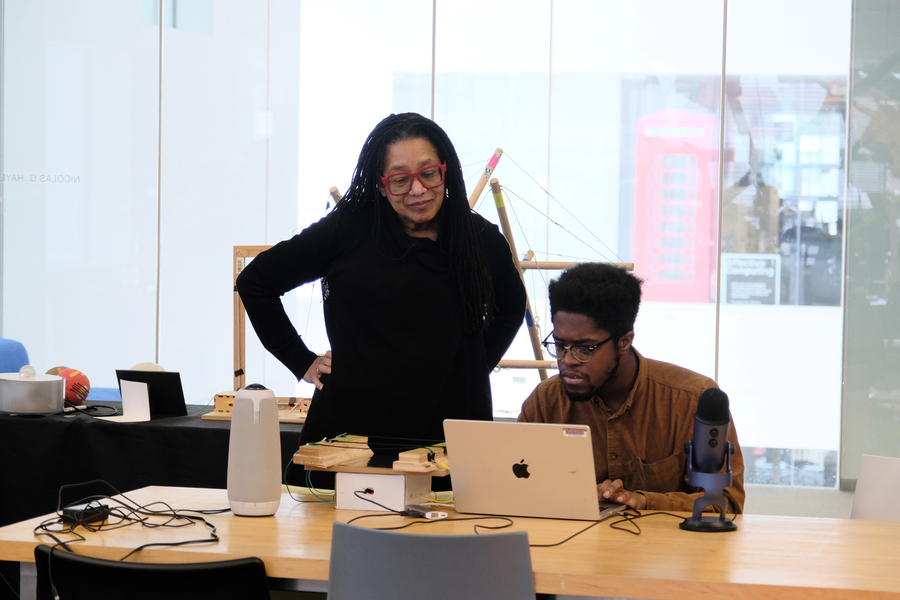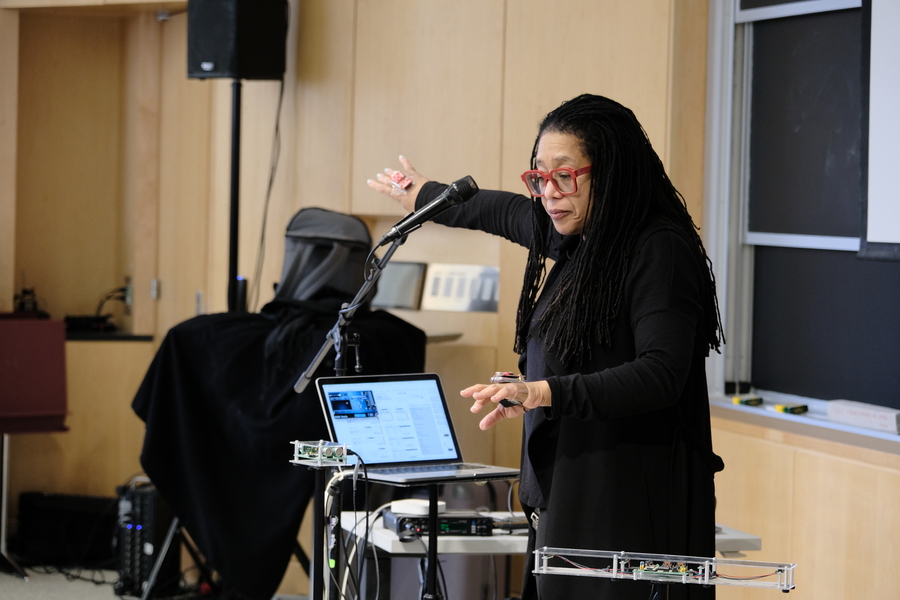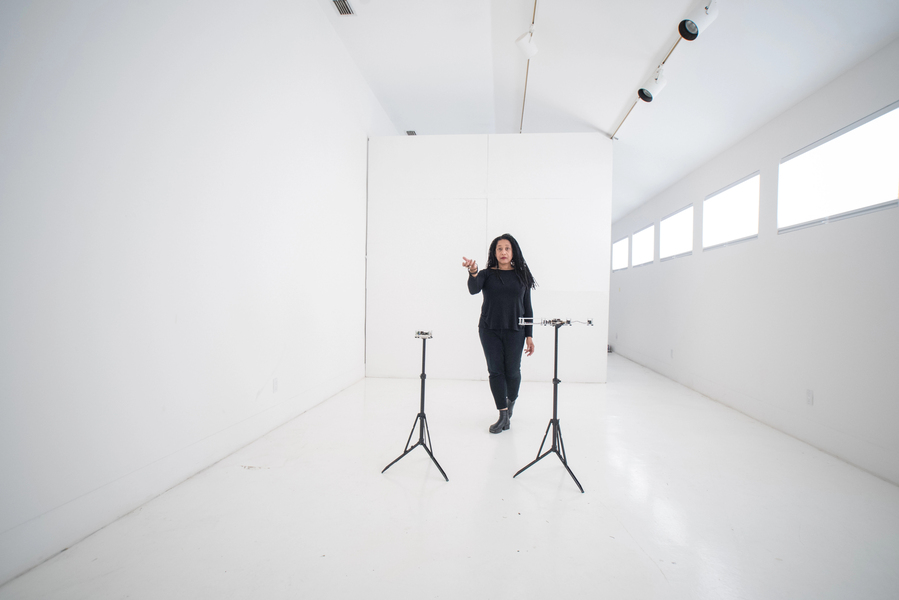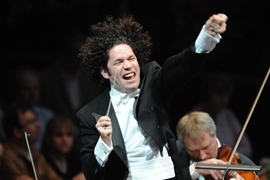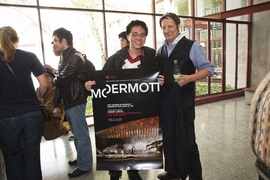In the mid-1980s, artist Pamela Z was working at Tower Records on Columbus Street in San Francisco, where one of her jobs was replacing pages in the store’s Phonolog, an enormous alphabetized directory of all the music available at the time, which formed a kind of bible of pop. When she ripped one loose-leafed sheet from the book, she noticed that all the titles on that sheet began with “you.” You stayed on my mind. You stole my heart. You stepped out of a dream. When spoken, the repetition of the words had an undulating, musical quality. It soon found its way into one of her electronic compositions, the found poetry processed with four-track cassette recorder, the simple list of phrases made incantatory through the looped rhythms of the human voice.
Pamela Z, the recipient of this year’s Eugene McDermott Award in the Arts at MIT, has become renowned for her pioneering work in live digital looping and interactive audio/video performance. Her voice is the centerpiece of these performances, manipulating and layering recordings in real time to produce complex sonic textures. Through the use of experimental extended vocal techniques, operatic bel canto, multimedia and sampled sounds, digital processing, and wireless MIDI controllers that use physical gestures to manipulate sound, Z creates immersive and magical aural collages.
While her first tool was a hollow-body guitar, which Z would use to accompany herself in clubs at night as she sang opera arias by day, her art changed once she discovered a digital delay in the '80s. “I came home from the music store, hooked everything up and started singing through it,” she remembers. “I never went to sleep that night because I was just looping my voice over and over again, and discovering beautiful properties of repetition, of layering, of being able to harmonize with myself, of being able to make complicated things by feeding back into the delay as I added more and more layers. I really think that I was never the same after that.” Having new technological tools, she said, allowed her to listen in new ways, discovering all the polyphonic dimensions within a single sound.
In the decades since, Z has sought possibility in the objects of everyday life — Slinkies, plastic water jugs, hair clippers, and power tools — working these found materials into densely layered compositions, woven through with her classically trained soprano. The sound of the freight elevator in her loft, a glass falling on the floor, or a fragment of conversation can all become defamiliarized and creatively repurposed in the work. What begins as a simple act of noticing, then, in the process of composition, evolves into much larger meditations on the human condition.
In the 2010 work “Baggage Allowance,” for example, the experience of hauling suitcases through airport security expanded into a philosophical investigation of memory, belonging, and what it means to carry things with you. “Her process is ‘Let's explore a subject area, or take these objects and put them together. Let's take this language and cut it up, letting its meaning evolve through examining it in what seems to be an objective way,'” says Evan Ziporyn, Kenan Sahin Distinguished Professor of Music and faculty director of the Center for Art, Science and Technology, “and then ending up with something very subjective, personal, and moving.”
At MIT, Z worked with students on their own compositions incorporating found sounds. The students, says Ziporyn, submitted their sounds two hours before the start of class. By the time the group met with Z, she had not only listened to each one but found in each something unique. What she modeled for the students, says Ziporyn, was a form of deep attention to a world swelling with sonic potential. “It was a good lesson in the idea of recontextualizing a sound that you find out in the world somewhere,” says Z, “And just by the act of recording it and listening to it on its own, you've already begun making a piece.” By the last session, she says, each student “had made really beautifully sculpted sound pieces.”
Z often performs her compositions with sensor-based, gesture-controlled MIDI instruments, wearing pieces of hardware as jewelry. Her gloved hands, like a conductor’s, summon sound from empty air. As part of her residency, Z performed a suite of her compositions for solo voice and electronics, ranging from early groundbreaking works to recently premiered ensemble pieces. Joining her, among musicians from the Boston area, were pianist Sarah Cahill, violinist Kate Stenberg, and flutist and MIT student Sara Simpson. Ziporyn conducted one of the pieces. For Z, the creation of the performance — its movements, feeling, and visuals — is deeply integrated into the process of composing itself. “It seems like magic — one voice becoming many, bird calls emerging and dispersing with the wave of a palm — but it’s really a multilayered virtuosity,” writes Ziporyn, “imbuing every aspect of Pamela’s work, smoothly masked by her grace as a performer. Pamela works with interactive music systems designer Donald Swearingen to develop the instruments and designs her own hardware, then learns how to use both as second nature.”
If some artworks fetishize the novelty of new technology, while others might dismiss it as somehow removed from what we perceive as human, Z has found a way to seamlessly combine digital tools with the ancient arts of performance, the manipulated sounds of the machine coalescing with the music of her own body.
Z’s expressive form of electronic music, Ziporyn says, reflects how we live today. It reflects the condition of living in a world mediated by technology, a world of bits and atoms, where the digital and analog are continually overlapping zones of experience. Her work, he says, defies any artificial separation between the so-called natural and the synthetic. And, as Z reminds us, we ourselves are electric: Everything we do, think, and feel is powered by the electrical currents coursing throughout the body. Her performances, says Ziporyn, are arguments for accepting that both the material and digital are part of what it means to think, feel, sense, and express — part of what it means to be human.
Presented by the Council for the Arts at MIT, the Eugene McDermott Award in the Arts at MIT was first established by Margaret McDermott in honor of her husband, a legacy that is now carried on by their daughter Mary McDermott Cook. The Eugene McDermott Award plays a unique role at the Institute by bringing the MIT community together to support MIT’s principal arts organizations: the Department of Architecture; the Art, Culture and Technology program; the Center for Art, Science and Technology; the List Visual Arts Center; the MIT Museum; and the Music and Theater Arts Section.
